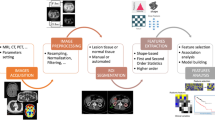Abstract
Purpose
Liver volume segmentation is important in computer assisted diagnosis and therapy planning of liver tumors. Manual segmentation is time-consuming, tedious and error prone, so automated methods are needed. Automatic segmentation of MR images is more challenging than for CT images, so a robust system was developed.
Methods
An intensity-based segmentation method that uses probabilistic model to increase the precision of the segmentation was developed. The model was build based on 60 manually contoured liver CT exams and partitioned into 8 parts according to the (Couinaud) segmental anatomy of the liver. The partitioning allows using different intensity statistics in different parts of the organ, which makes it insensitive to local intensity differences from MR artifacts or pathology. The method employs a modality independent model with registration that exploits some LAVA image characteristics. This dependence can be eliminated to adapt the segmentation method for a wide range of MR images.
Results
The method was evaluated using eight representative, manually segmented MR LAVA exams. The results show that the method can accurately segment the liver volume despite various MR artifacts and pathology. The evaluation shows that the proposed method provides more precise segmentation (6% average absolute relative volume error) compared with global intensity statistics for the whole organ (20% average absolute relative volume error). The compute time of the method was 30 s in average, which is acceptable for wide range of clinical applications.
Conclusion
An automatic method that can segment the liver in contrast-enhanced MR LAVA images was developed and tested. The results demonstrate that the method is feasible, efficient and robust to artifacts and pathology.
Similar content being viewed by others
References
Furukawa D, Shimizu A, Kobatake H (2007) Segmentation method based on maximum a posterior probability estimation and level set method. In: MICCAI 2007 workshop proceedings: 3D segmentation in the clinic. 117–124
Rusko L, Bekes G, Fidrich M (2009) Automatic segmentation of the liver from multi- and single-phase contrast-enhanced CT images. Med Image Anal 13(6): 871–882
Heimann T, Meinzer HP (2009) Statistical shape models for 3D medical image segmentation: A review. Med Image Anal 13(4): 543–563
Seghers D, Loeckx D, Maes F, Vandermeulen D, Suetens P (2007) Minimal shape and intensity cost path segmentation. IEEE Trans Med Imaging 26(8): 1115–1129
van Rikxoort E, Arzhaeva Y, van Ginneken B (2007) Automatic segmentation of the liver in computed tomography scans with voxel classification and atlas matching. In: MICCAI 2007 workshop proceedings: 3D segmentation in the clinic. 101–108
Kainmuller D, Lange T, Lamecker H (2007) Shape constrained automatic segmentation of the liver based on a heuristic intensity model. In: MICCAI 2007 workshop proceedings: 3D segmentation in the clinic. 117–124
Li H, Elmoataz A, Fadili J, Ruan S (2003) An improved image segmentation approach based on level set and mathematical morphology. In: Proceedings of SPIE vol 5286. 851–854
Farraher SW, Jara H, Chang KK, Hou A, Soto JA (2005) Liver and spleen volumetry with quantitative mr imaging and dual-space clustering segmentation. Radiology 237(1): 322–328
Hermoye L, Laamari-Azjal I, Cao Z, Annet L, Lerut J, Dawant BM, Beers BEV (2005) Liver segmentation in living liver transplant donors: Comparison of semiautomatic and manual methods. Radiology 234: 171–178
Bismuth H (1982) Surgical anatomy and anatomical surgery of the liver. World J Surg 6(1): 3–9
Heimann T, van Ginneken B, Styner MA, Arzhaeva Y, Aurich V, Bauer C, Beck A, Becker C, Beichel R, Bekes G, Bello F, Binnig G, Bischof H, Bornik A, Cashman P, Chi Y, Cordova A, Dawant BM, Fidrich M, Furst JD, Furukawa D, Grenacher L, Hornegger J, Kainmuller D, Kitney RI, Kobatake H, Lamecker H, Lange T, Lee J, Lennon B, Li R, Li S, Meinzer H-P, Nemeth G, Raicu DS, Rau A-M, van Rikxoort EM, Rousson M, Rusko L, Saddi KA, Schmidt G, Seghers D, Shimizu A, Slagmolen P, Sorantin E, Soza G, Susomboon R, Waite JM, Wimmer A, Wolf I (2009) Comparison and Evaluation of Methods for Liver Segmentation From CT Datasets. IEEE Trans Med Imaging 28(8): 1251–1265
Author information
Authors and Affiliations
Corresponding author
Rights and permissions
About this article
Cite this article
Ruskó, L., Bekes, G. Liver segmentation for contrast-enhanced MR images using partitioned probabilistic model. Int J CARS 6, 13–20 (2011). https://doi.org/10.1007/s11548-010-0493-9
Received:
Accepted:
Published:
Issue Date:
DOI: https://doi.org/10.1007/s11548-010-0493-9




